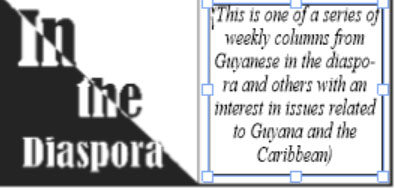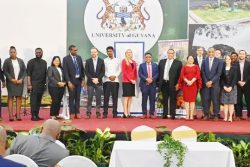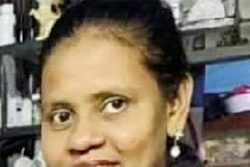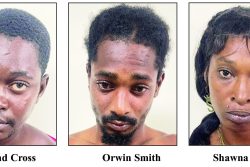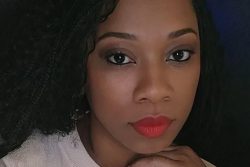By Kala Ramnath
Kala Ramnath received her MPhil in International Relations from Trinity College, Cambridge University and her PhD from the University of Hull. Active in the field of disability at both an academic and applied level, she is co-founder of the Step-By-Step School in Guyana.
 One of the perennial ‘hot potato’ issues in the Caribbean Region is the idea of marginalisation. Ethnic marginalisation, to be precise. Mention the term ‘ethnic marginalisation’ in the Caribbean and the reaction you get depends pretty much on who you are talking to. The average Indo-Caribbean would be inclined to agree, regaling you with tales of discrimination as long as Independence itself. To the average Afro-Caribbean, one might get a shrug and a curt dismissal about ‘those people are well sorted in business what is their problem’ type of response. The roots of this of course lie in the post-emancipation colonial dynamics as one group was effectively shipped in and shunted off to rural plantations to replace the other group, many of whom were heading for the urban sprawl of the cities. The relative lack of interaction, added to the informal ethnic designation of villages, accentuated the mutual distrust
One of the perennial ‘hot potato’ issues in the Caribbean Region is the idea of marginalisation. Ethnic marginalisation, to be precise. Mention the term ‘ethnic marginalisation’ in the Caribbean and the reaction you get depends pretty much on who you are talking to. The average Indo-Caribbean would be inclined to agree, regaling you with tales of discrimination as long as Independence itself. To the average Afro-Caribbean, one might get a shrug and a curt dismissal about ‘those people are well sorted in business what is their problem’ type of response. The roots of this of course lie in the post-emancipation colonial dynamics as one group was effectively shipped in and shunted off to rural plantations to replace the other group, many of whom were heading for the urban sprawl of the cities. The relative lack of interaction, added to the informal ethnic designation of villages, accentuated the mutual distrust
The people of the Region are largely Afro-Caribbean with a growing and bewilderingly diverse mixed race population. We also have a significant Indian presence in both Guyana Trinidad, and Suriname, if we include the wider Caribbean. There are also small populations of Indians in Jamaica, St Vincent, St Lucia and Grenada. Alongside Indians, Guyana, Dominica and Belize have significant numbers of Indigenous peoples. In Guyana there are 9 different indigenous groups which comprise about 13% of the population- a fact that is barely known in the rest of the Caribbean. Add to this the small but longstanding presence of Chinese, Syrian-Lebanese and other groups and we can truly call ourselves an ethnically-diverse region.
But how does this stack up with images of the Region to the outside world? More importantly, how does this stack up to our own diverse selves? And for our kids in school? Are we seeing ourselves in popular culture and sports? Are we sufficiently represented in our wonderful diversity in our societies? Are we represented in our textbooks? Raising these issues can be a pretty contentious issue which then leads to the perpetuation of clichés and stereotypes. How many of us know of the Akawaio, the Lokono and Wapishana presence in Guyana or of the Mayans in Belize whose ancestors have been living and traversing boundaries for thousands of years? Or, beyond the roti, curry and doubles clichés, how many non-Caribbeans know about the formidable Indian presence in the Caribbean for over 170 years? Why is this idea of a multi-ethnic, truly diverse Caribbean so contentious? When Frank Birbalsingh wrote a book about the marginalisation of Indo-Caribbean cricketers a few years ago, it was not well received in some quarters. But ask any Indian in T&T and Guyana and they can probably reel off a long list of grievances, including selection criteria, some dating back to the 1950s and 60s, others to do with the shabby treatment of Alvin Kallicharran when he decided to tour with the Windies rebel tour of South Africa, when compared with the treatment of his African colleagues. These rumblings continue in cricket to this day. The fissures are sadly all too real. And it starts with our divide and rule political history which persists. In Guyana and T&T our entire post- independence histories have been dominated by race. Our politics is effortlessly fissured by race. Indians vote for one party. Africans vote for another. Not much has changed since the 1960s. The deleterious effects of this on the development of the Region has been a matter of academic study for some time, and is beginning to enter into public discourse more fully, although some of these discussions can come with their own health warnings about political and/or racial bias. But deal with it we must.
In February this year an interesting piece of research passed under the radar until it was raised by one Indo Caribbean critic recently in an Indo-diaspora paper. Swami Askharananda mentioned that Dr NK Mahabir had presented a paper titled ‘The Marginalisation and Exclusion of Indians by the Caribbean Education Council (CXC) in the CSEC and CAPE History and Literature Syllabi,’ at a conference sponsored by the University of the West Indies and somewhat ironically titled ‘Conference on Inclusive Education: Achieving Education for All.’ Dr. Mahabir examined CSEC and CAPE syllabuses for Literature for the period 2015 to 2017 and found what appeared to be the near exclusion of Indian writers from the list of dramas, poems, novels and short stories. There were largely Afro-Caribbean writers from Barbados, Ireland and Scotland (1 each), Guyana (3), St Lucia and Africa, (4 each), Jamaica (5), England (6) and the USA (9). However, there was none from writers of Indo-Caribbean or Indian origin
As the Swami noted, ‘Dr Mahabir also looked at the ethnic breakdown of the writers in the CXC list of 32 and found that 15 are Africans or persons of African origin and 10 Whites. He concluded, “No Indian playwright, poet, novelist or short-story writer was chosen, although Indians and (People of Indian Origin) PIO form the majority ethnic group in Trinidad and Guyana, as well as the largest minority in Jamaica, Grenada, St. Vincent and St. Lucia. Not even Trinidad-born V.S. Naipaul, Nobel Laureate for Literature and arguably one of the greatest writers in the English Language, seemed worthy enough to be on the CXC list.”
The CXC to its credit, appeared to have recognised these concerns by April of this year and seemed to have taken on the services of Dr Mahabir. I later learnt that finally, books by Indo-Caribbean and Indian writers are going to be included in the CSEC curriculum for this upcoming academic year. On the list are Ismith Khan’s Jumbie Bird, three of Naipaul’s books, Chip Chip Gatherers by his brother Shiva and two from RK Narayan of India. Worryingly, prior to Dr Mahabir’s research, one wonders how long this has been going on and why this disgraceful state of affairs has persisted.
Likewise, the issue of the long marginalised indigenous peoples of the Region, particularly in Guyana and Belize has also been a very uncomfortable fact of life; a reality lived by them. An inconvenient truth, if you will. Spatial marginalisation almost begets policy marginalisation. And this leads to a certain invisibility in national political discourse, the ‘othering’ of these original peoples as irrelevant to the otherwise divisive national political mainstream. An Amerindian academic and friend of mine mentions that teachers in his areas are very disillusioned because the CSEC curricula barely mentions their existence beyond a few sparse, perfunctory lines in the beginning of history texts. The results for these Caribbean examinations remain unsurprisingly poor. Amerindian children in the interior are torn between going to Georgetown or to Boa Vista across the border in Brazil to perform menial but income generating jobs, and feeling pressured to stay put by their parents who want them to do the traditional tasks like hunting. A few manage to climb the ladder to jobs in teaching or nursing, but by and large, indigenous peoples remain sadly side-lined by an educational system that barely recognises their existence as Caribbean peoples. The marginalisation of Amerindian communities, with their eco-centric views of the natural world and the potential they have to help us learn to craft our own development strategies in a climate changed grounded world for the foreseeable future, behoves us to think beyond the box and open up the policy space to them.to help us. Equally. And, of course there are other fundamental issues like access to land and title, linguistic rights and continued economic exploitation.
Edward Said, Gayatri Spivak, Homi Bhabha, Noam Chomsky and other theorists have talked about oppression and marginalisation via education. Education, clumsily or badly deployed in multi-ethnic societies, can play havoc with social cohesion. Real development depends on a critical recognition and value placed on all groups. More importantly, it has the potential to help us achieve otherwise laudable but elusive national development goals. Marginalisation, much like a self-inflicted wound (in this case), not only festers, but can cause, at best an unnecessary haemorrhage, a waste of valuable time and human and material capital, it undermines and cripples the very essence of the thing we want to achieve. At worst, it can lead to chronic, irreversible decline and permanent damage to the society we want to build. One that we say we aspire to. Social cohesion thus means inclusion. It is an integral part of the nation building process.
Happily, it seems that the CXC authorities recognised this and have begun to institute changes. But at a broader national and Regional level, we need to stop and listen without fear or favour. We have to open up the space for dialogue not only to lance a boil that we see festering in social media daily in both countries, but also boldly create space where we can address these issues before we get to the danger zone. Fear of raising voices has been a long-standing concern as people do not want to be accused of racism, so they have these secret conversations within their own ethnic groups. There is also the issue of hopelessness, that is, the idea that things will never change no matter how much noise is made. So people just get on with their lives until something else crops up. The feeling has been voiced that we can far more easily recognise racism in the so-called white man’s country (taken from indigenous peoples too), but don’t see it in our own and instead become active or passive agents of perpetuating oppression. We need to find ways to talk about race and marginalisation in the Caribbean. The alternative is too terrible to contemplate.
